How to Write a Spec Script
How to Write a Spec Script
There’s no shortage of “How to Write a Spec Script” posts out there, and they tend to come in two forms. Articles about writing on spec either spotlight “business side” considerations — marketplace demand, how to get your material out there, which contests to enter — or they give guidance on the creative process: how to find inspiration, ways you can push your imagination, and spec script format.
In truth, writing good scripts comes down to a balance.
In this post, we provide that balance, all with the goal of leading you, our reader, to spec script sales. We analyze industry realities and share techniques to give you the tools to strategically write good scripts and find work as a writer.
After all, the film and TV industry has always walked a line between bare-knuckle business and cutting-edge creativity. It’s equal parts art and commerce. Writing on spec and getting ahead requires a two-pronged approach without sacrificing momentum. So read on, and get rolling.
WRITING ON SPEC
1. Writing a spec script today
Writing on spec is a common practice in Hollywood. Whether or not they’re “in the industry,” film and TV specs can be a great tool for writers to sell their voice to potential buyers.
In this post, we cover both feature film and TV spec scripts.
So exactly what is a “spec” script?
SPEC SCRIPT DEFINITION
What is a spec script?
A “spec” (speculative) script is a film or television script written independently of a production entity. “Writing on spec” refers to when a writer crafts a script on his or her own, with the goal of either selling it or securing representation for further assignments.
The best spec scripts are ranked by The Black List yearly.
Why write a script on spec?
- Gain screenwriting practice.
- Generate material to show to producers and reps.
- Showcase your ability as a writer.
SPEC SCRIPTS
2. Can writing on spec pay off?
It has been debated whether or not writing on spec can be valuable. After all, today’s entertainment landscape is dominated by franchises and existing properties with built-in audiences (like comic books).
Additionally, it is virtually impossible to get an unsolicited script read by a production company.
So why is anyone writing on spec?
Markus Redmond sold his script
Well, the goal for any writer is to generate momentum behind their name or their project. This can lead to meetings with producers, representation, and meeting with head writers of popular shows.
If you have a spec that gets you noticed, that’s only the first step. Once you get into a room, you’ll also get asked if you have more materials to show.
That’s why veteran screenwriter John August suggests arming yourself with an additional feature film spec, a sample episode spec, and a pilot.
SCRIPT WRITING
3. How to write a spec script
First thing you need is a professional screenwriting software that uses industry standard formatting so that your script will be taken seriously.
StudioBinder has screenwriting software that is the total package:
First off... it is completely FREE.
You can write an unlimited amount of scripts without spending a dime.
Our feature guides you through the writing process, and teaches you the industry standard format that has been used by professionals for decades.
While you write your script, you can simultaneously tag all of the elements like props, costumes, or any other requirement for your scene.
Once that is done, you can begin writing your spec script:
When approaching any writing project, it’s always recommended to write an outline or treatment to get your ideas solid.
That way you won’t get lost in a maze of ideas.
Then, when you actually set to writing, keep your eventual reader in mind.
Even more important than the agents and producers you wish to attract are their readers. These are usually assistants with tall stacks of good scripts like yours to get through every day.
Writing on spec pro tips: how to write better descriptions
So you’ll want to do a few things to keep them engaged.
First, make sure your scripts follow industry standards. Don’t try to spice them up with fancy titles, fonts, or images. As far as spec script format, generally just make sure your script looks like any other professional script.
Here at StudioBinder, we’ve put together a TV Writing & Development Master Class which will take you through each step of the development process, and keep you on track while you write your ideas.
The lessons included in these seven separate courses will not only help you write, but we also go over a bunch of industry insider information and advice from successful writers and show runners to help you sell the idea.
TV WRITING ON SPEC
4. Create a sample episode of a show
Choose the show that you sample wisely. The end reader will be agents, producers, and their assistants, so make sure this show is both current and making a splash in the industry. Then become a disciple of the show.
Know the characters, tone and structure inside out. Watch as many episodes as you can, and take note of all of those things
How to write a spec script for television
Remember that, due to legal and creative reasons, most showrunners won’t read sample episodes of their own shows. But they are valuable tools to get you staffed on similar shows.
Writing on his blog, John August also suggests calling production companies during staffing season (April to May) to discover what sample episodes the respective producers are reading.
HOW TO WRITE A TV PILOT
5. Write your original TV pilot
A pilot is an introductory episode to a series. Naturally, it takes a bit more effort to write a pilot spec than it does to write a spec script for an existing show. That’s because in a pilot, you are creating everything — characters, world, tone — from scratch.
Even though you are starting with a blank page, anchor your vision with as many successful (and similar) shows as you can.
How to Write a TV Show Pilot that Sells - StudioBinder
For example, while writing Extant, Mickey Fisher said that he took notes while watching several episodes of shows like Breaking Bad and Friday Night Lights. His notes were about episode structure and length.
Fisher said that, in addition to writing his pilot, he also wrote a season and series overview which gave him ammunition when getting asked questions in meetings.
SPEC SCRIPT FORMAT
6. Write your original feature film
It’s true: the number of films that major studios produce every year is on a downward trend. So, naturally, the appetite for original spec screenplays isn’t what it once was.
But that doesn’t mean spec film scripts don’t get sold. Considering the new avenues for content, including Netflix, Amazon, and even Apple, there is still an appetite for original material.
An agent can help you with that. But it’s also valuable to keep your eye on the market. Boil your idea down to its most basic genre and premise, and look at similar films that have come out in the past few years.
Write a feature film spec script
Do some research. How were they initially financed? Perhaps it wasn’t purchased as a spec. Sometimes, ultra-low-budget horror film scripts, for example, are produced for cheap and then sold to distributors later.
Research distributors, too. Try to think about their angle for having released a film.
Consider how your story plays to market demand.
Finally, enter script contests. Pick from a host of high-value screenwriting competitions and narrow down to the ones that satisfy the genre and tone of your script.
Also, there are legitimate success stories stemming from the Black List. This is a screenplay upload service that offers feedback and a voting functionality.
You have to pay to get reads in the Black List, but this can result in your script getting seen by the right person at the right time.
HOW TO WRITE A SCRIPT
7. Find your voice in your spec script
Don’t be intimidated by the prospect of needing so much material all ready to go. What will get you noticed in the first place is the way you express your own unique perspective and worldview.
Mickey Fisher wrote at length about his journey from being an aspiring writer-actor to having his show, Extant, get executive-produced by Steven Spielberg on CBS.
Chief among the many nuggets of wisdom he provides in his post is his advice to make your writing portfolio as tethered to your voice as possible.
He says that, at first, he tried to diversify his potential projects as much as possible. But the lukewarm response he got guided him to align his portfolio closer with what got him noticed in the first place.
So get familiar with that aspect of yourself. Make a moodboard to capture images that inspire you. Ask yourself why each image you add is particularly striking.
Dig deep into that creative part of yourself.
SPEC SCRIPT EXAMPLES
8. Film and TV script examples
The best way to learn how to write a spec script is from existing scripts. The more you read, the more you’ll learn how to write a spec script like the pros.
Find a good TV spec script example in a database of produced and unproduced scripts. Study as many episodes and pilots of similar, relevant shows as you can.
For a film script, consider checking out past winners of the annual Black List. Think particularly about how each script stood out in the marketplace.
Writing Sitcom Script: Analyzing Seinfeld Script
The Sitcom has been a staple in television for over 70 years, but creating a successful muti-camera all starts with the script. We’re going to breakdown the anatomy of arguably the greatest sitcom script of all time: Seinfeld – The Switch.
At the end you’ll be able to download a FREE Seinfeld script PDF.
SEINFELD SITCOM SCRIPTS PDF
What makes Seinfeld scripts timeless?
How do you make a timeless sitcom? Most of it starts with having a killer script. Some of the most successful shows in history used a multi-camera format, recorded in front of a “live television audience”.
In 1989, something very significant happened in the sitcom world.
This was the philosophy behind arguably the greatest show of all time, Seinfeld.
Every working writer in Hollywood wants to create a show that runs for nine seasons, and 180 episodes. Building a net-worth of $870,000,000 isn’t too bad either.
Writing a sitcom that has this kind undeniable power has only been done a handful of times, which is why we set out to understand how Seinfeld connected with the viewer.
We’re going to take you through the science and structure behind Seinfeld scripts.
SEINFELD SCRIPTS
The Seinfeld script formula
What makes Seinfeld so unique as a show is that it has no real interest in change. This is somewhat common with sitcoms, but they took it to a whole new level that has since been replicated again and again.
One of the first lessons a screenwriter will learn is that their characters need to go through significant change, so that the viewer can go on an emotional journey with the characters in the script.
But “in a world” of tired tropes and formulas, stand-up comic Jerry Seinfeld and writer-producer Larry David created the ultimate show about nothing
The Seinfeld writers had very little interest in moral behavior, but are completely focused on the group's depraved version of ethics.
The creators of Seinfeld - Larry David (left) and Jerry Seinfeld (right)
That isn’t to say Seinfeld doesn’t have a formula, but the entire sitcom is built around resistance.
Resistance against the formulas that govern so many other shows.
THE SEINFELD SCRIPT FORMULA
- Identify and label the problem.
- Try to outsmart the problem.
- The problem outsmarts you.
Jerry is the hero.
Well, not a hero exactly, but the show is named after him, and the Seinfeld sitcom formula is mainly interested in Jerry’s arc throughout the episode. The is what the Seinfeld writers focused on.
There may be two or three different subplots in each episode, but they are just funny ideas that work — and their place in the Seinfeld script formula is far less rigid.
Let's see what Seinfeld writer Peter Mehlman has to say:
This statement shows that Seinfeld and David are not about forcing an agenda, but rather allowing the organic convergence of funny ideas.
Sometimes it works better than others, but the jokes and the situations in the script are always funny, and often still hold up today.
SEINFELD CAST
The Seinfeld characters
Seinfeld characters each have their own unique ways of attacking problems in the script, so let's take a look:
The cast of Seinfeld
SEINFELD SITCOM SCRIPTS: ACT I
Act I (Pages 1 to 7)
We’re going to take you through the anatomy of the classic Seinfeld script "The Switch," and show you the formula in action.
Cold open
The vast majority of Seinfeld episodes begin with Jerry on stage performing stand-up comedy in front of a hip New York audience.
These openings can act as a quick little preview of the upcoming plot, or simply provide a joke that is related to some essential part of the episode. This only takes half a page, and is a great way to get laughs while keeping a nice pace.
Seinfeld about tennis
The routine above tells us that the episode has to do with Tennis. This opening isn’t particularly prescient, but it is relevant enough to transition us to the first scene, which takes place in...
A tennis pro-shop.
INTRODUCE THE MAIN "PROBLEM"
The writers always label a problem for the main characters to “solve”.
In this episode, Jerry tells a funny joke, but his new “love interest” just nods. Elaine points out to Jerry, “Have you noticed she never laughs?”
Elaine helps identifiy Jerry's Problem
Now we have established Jerry’s problem (the main problem):
Jerry is dating a “non-laugher”, which is ironic because he is a comedian.
SUBPLOT A "PROBLEM"
Seinfeld often has problems that involved Jerry’s friends. We call these subplots
For Subplot A: While at the tennis club, Elaine tells Jerry she needs to retrieve a tennis racket for her boss, which she then politely lends to a possible future-employer.
Elaine makes the selfish decision to gamble with something that doesn’t belong to her, all in an effort to ingratiate herself with a more favorable employer.
Jerry helps identifiy Elaine's problem
SUBPLOT B "PROBLEM"
George and Kramer walk down the street, and discuss how George’s new fashion model girlfriend may be bulimic.
Remember: These subplots have the ability to connect to the main story, and go though a similar arc, but the formula at work only needs to work with Jerry. He is our hero.
Kramer helps identify George's problem
TRY AND FAIL
You need Jerry to Try and Fail before you can end Act I.
This first attempt is pretty low-stakes, and often is just a confirmation of suspicion rather than an actual remedy. This is where we get to see his selfish nature churn.
Jerry tries to outsmart his problem: Attempt #1
Jerry has no intention of asking her if she finds him funny. He has no interest in hashing out this problem in a mature manner. He just wants to confirm his suspicions.
In this episode, George has a very similar experience with his issue. Meanwhile Elaine attempts to get the tennis racquet back, but is too polite to retrieve it.
Each subplot has its own unique try and fail, but their place within the act structure isn’t as precise as it is with Jerry’s plot - the main plot.
COMMERCIAL BREAK #1
Seinfeld understands that no matter what, you need to cut to commercial with a big piece of information, and hopefully a big laugh.
In this episode, they cut to commercial after learning that Kramer’s first name is...
Cosmo.
Seinfeld - Kramer's first name
It doesn’t need to fit into some little formulaic box beyond basic satisfaction. Just make us laugh, and make us come back for Act II.
If you can bring the joke back later... even better.
SEINFELD SITCOM SCRIPT: ACT II
Act II (Page 8 to 15)
REMIND THE VIEWER
Seinfeld scripts do a great job of resetting the stage for the viewer, and reminding us of the problem Jerry faces. They would quickly explain where we were, how we got there, and where to go from here.
Jerry mentions how he tried, and failed
At this point in a Seinfeld script, we're reminded of Jerry’s problem, and all the separate problems in the various subplots.
At this point in "The Switch," George enters the apartment and publicly declares that he “heard a noise”.
This is in reference to his girlfriend forcibly “refunding” in the ladies restroom.
Seinfeld - George Bulimic date
THROW A WRENCH IN THE GEARS
In the middle section of the show, something will be introduced that ultimately derails the situation, and changes our view moving forward.
In this episode, Jerry goes to pick up his love interest at her apartment, but is met by her ATTRACTIVE ROOMMATE only to find...
She has a great laugh!
A wrench is thrown in the gears when Sandy's roommate has a great laugh
Now we have a new development that has changed the landscape of the episode.
This is very similar to the South Park Formula:
This happens, but then this happens, therefore this happens.
It isn’t enough to string events together. There needs to be a causal relationship that breeds conflict, even if it is a simple as doubt or desire.
The subplots at this point are separate, and each character is off dealing with them in their own unique way. We don’t get bored or bogged down by a singular story or tone.
George is still cynical. Elaine is still too polite. Both are still funny.
FORM A NEW PLAN
Jerry has tried and failed once (testing the non-laugher) but now it is time to try again, and this time you need to raise the stakes. His selfish nature needs to stretch its legs, and the group needs to begin to gamble on something.
This is where our episode title, The Switch, comes into play:
Jerry and George form a new plan
Jerry and George spend the rest of Act II figuring out a way for Jerry to switch from his current love interest, to her roommate without incident.
It’s a selfish gamble, and if it pays off, it will allow Jerry to date without inconvenience.
Seinfeld - George's plan
COMMERCIAL BREAK #2
They follow the formula by cutting to commercial break with this moment:
Commercial break #2
As you can see, this is a big reveal, and it’s a really, really funny moment.
SEINFELD SITCOM SCRIPT: ACT III
Act III (Page 16 to 22)
FINAL PREPARATION
This is similar to the Remind the Viewer section of Act II, because we’ve come back from another commercial, and we need to remind our viewers of the old problems as well as the new developments.
In this episode, the writers have Jerry and George unfold their big plan:
Jerry and George do their final preparation
They have set the stage for Jerry to gamble.
We know that what he really wants is to date the other roommate, and that is the goal.
Watch Seinfeld. You’ll will see that their goals are rarely achieved. It doesn't need to fit into a tiny box, or have a moral lesson...
It just needs to be funny.
LAST ATTEMPT
This is where Jerry attempts his final plan. This has to blow up in his face in some way, but that doesn’t always have to be a negative result; just a funny surprise.
Jerry attempts "The Switch"
The Switch:
Jerry attempts to outsmart his problem: Attempt #2 "The Switch"
COME FULL CIRCLE
How the show cleverly wraps up all of the seemingly unconnected stories into one big narrative is often what many people say is their favorite aspect of Seinfeld.
This is less scientific than many think, and much of this is nothing more than efficient television writing.
The characters often meet back at Jerry’s place to debrief.
They each discuss how their unique attempts to solve their problems have gotten the better of them. A subplot will connect with another, and then each will come to some form of resolution, staggered, like race cars crossing a finish line.
In The Switch, Jerry explains his attempt to trade roommates, but this has no bearing on George’s problem, or Elaine’s, or even Kramer’s.
The connecting stories are all subplots in this episode.
George tasks Babs (Kramer’s restroom-matron mother) to confirm his suspicions that his girlfriend is bulimic, but she quits (on behalf of Kramer’s request) without telling George, therefore setting him up for a humiliating public failure.
Elaine needs a stand-in tennis racquet for her boss, and Newman (Jerry’s neighbor) owns the same model racquet, which is somewhere in his apartment.
Kramer offers to let Elaine borrow the racquet...
Plot and subplot begin to combine
As the group enter Newman’s apartment, this happens:
We come full circle
FINAL THOUGHTS ON SEINFELD SCRIPTS
Less is more in a sitcom script
Seinfeld scripts don't need to constantly raise the stakes. Often the show lowers the stakes. The smaller the problem, the better.
Because there is no need to make a big statement beyond what's funny, and if it isn't funny, it doesn't make it in the show (hopefully).
Many other shows focus on being bigger, louder, and more severe.
Bigger stakes, more characters, more to be learned, more to be changed.
Seinfeld deals with less.
Fewer characters, smaller stakes, trivial pursuits.
The best golfer is often the person with the fewest clubs in their bag.
So it goes for sitcom scripts.
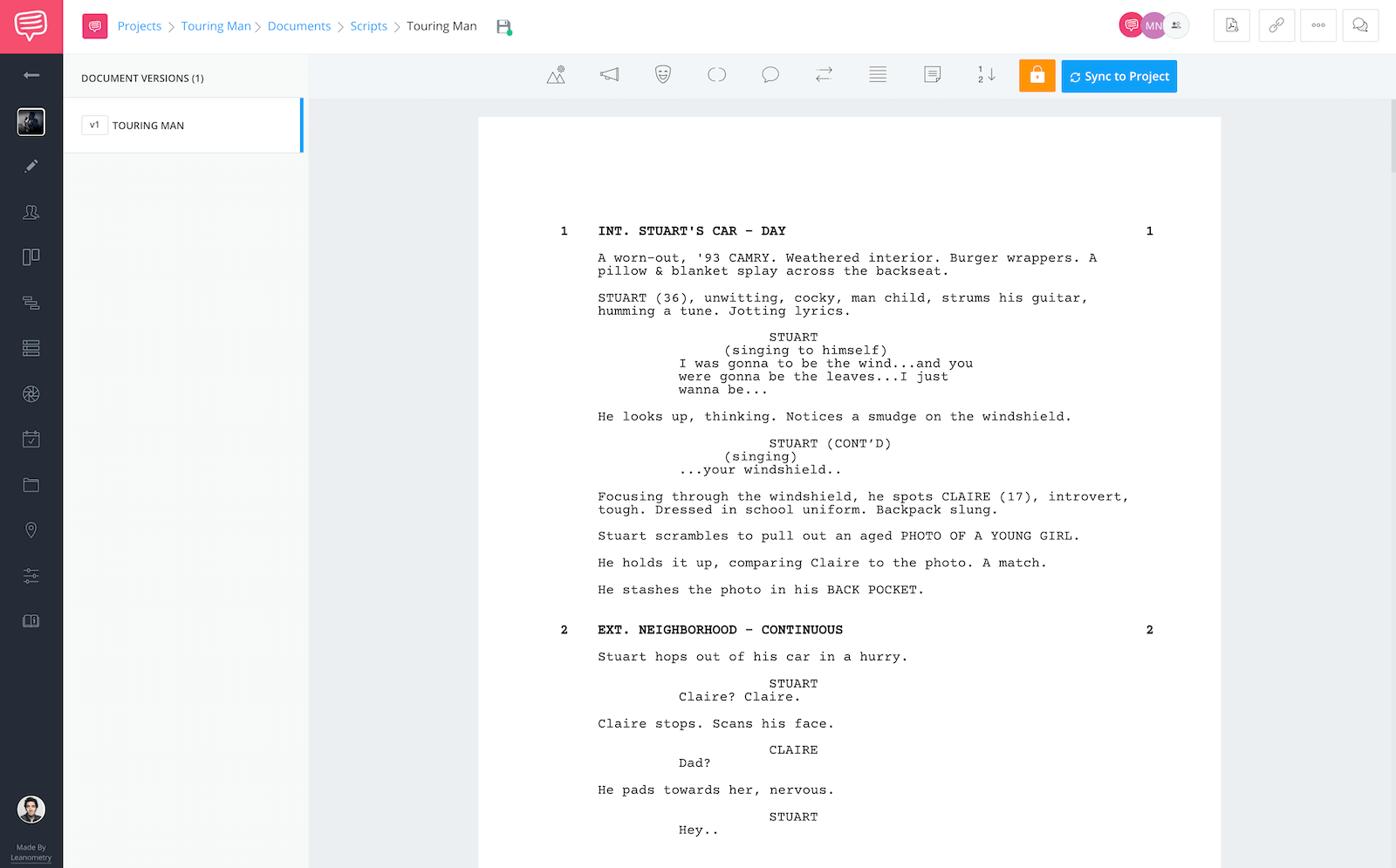
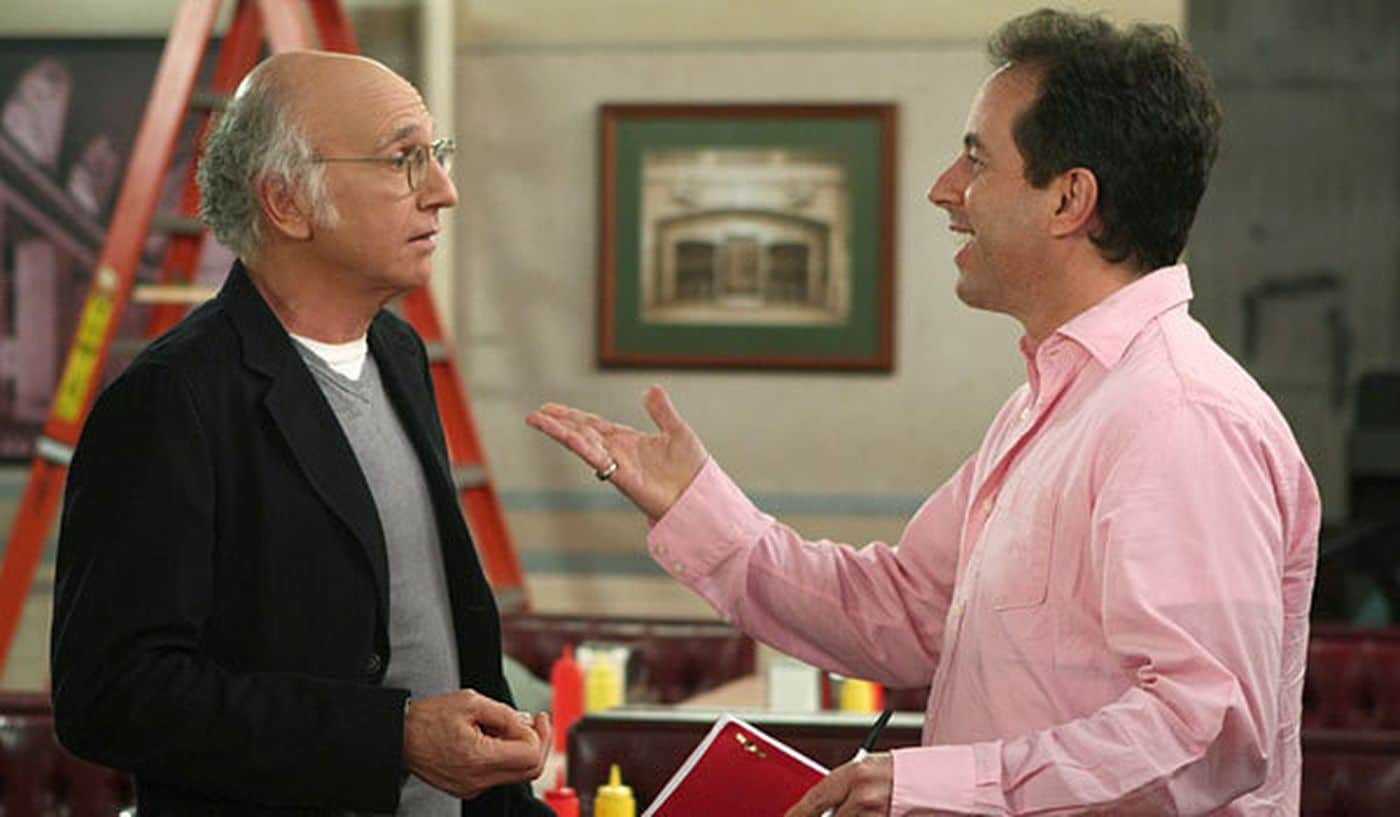
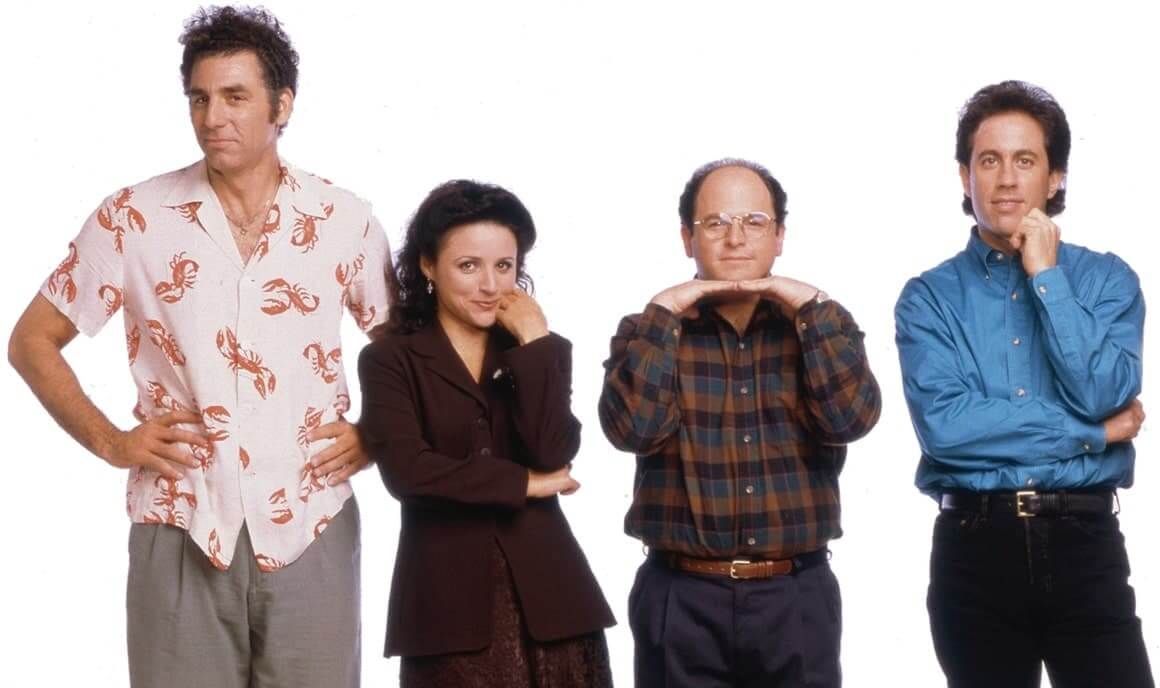
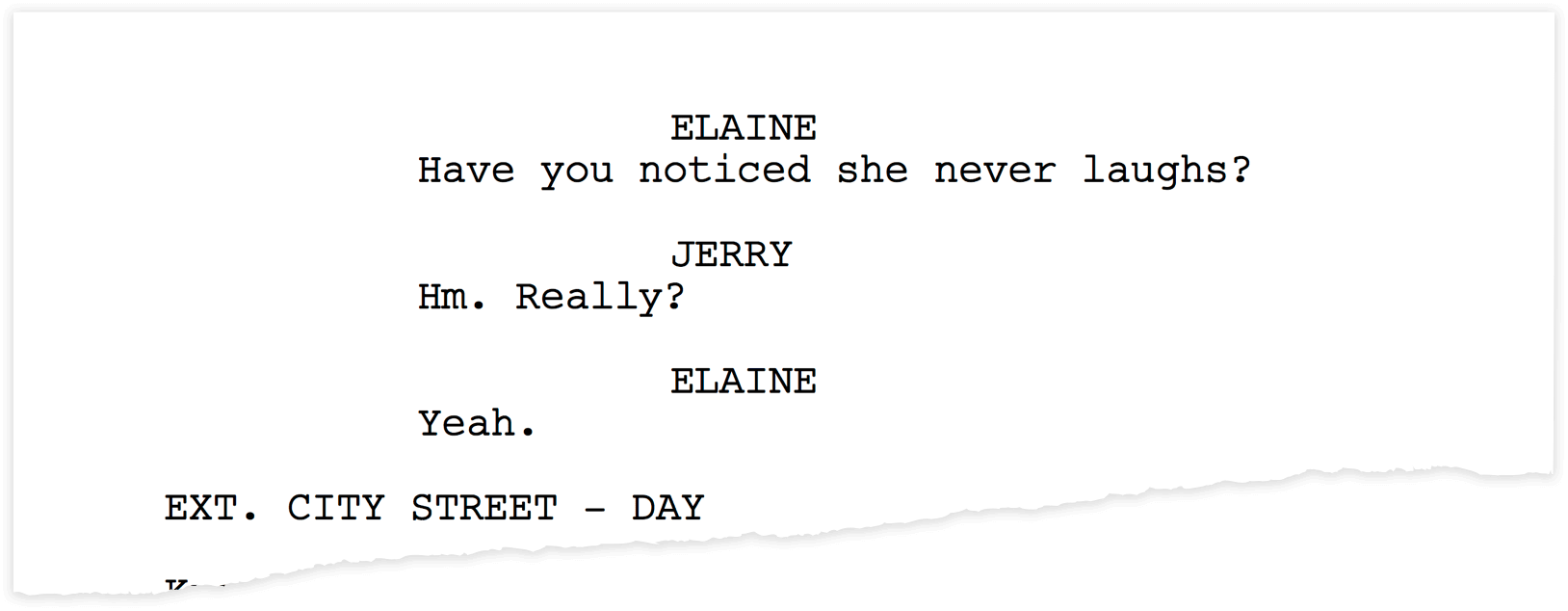

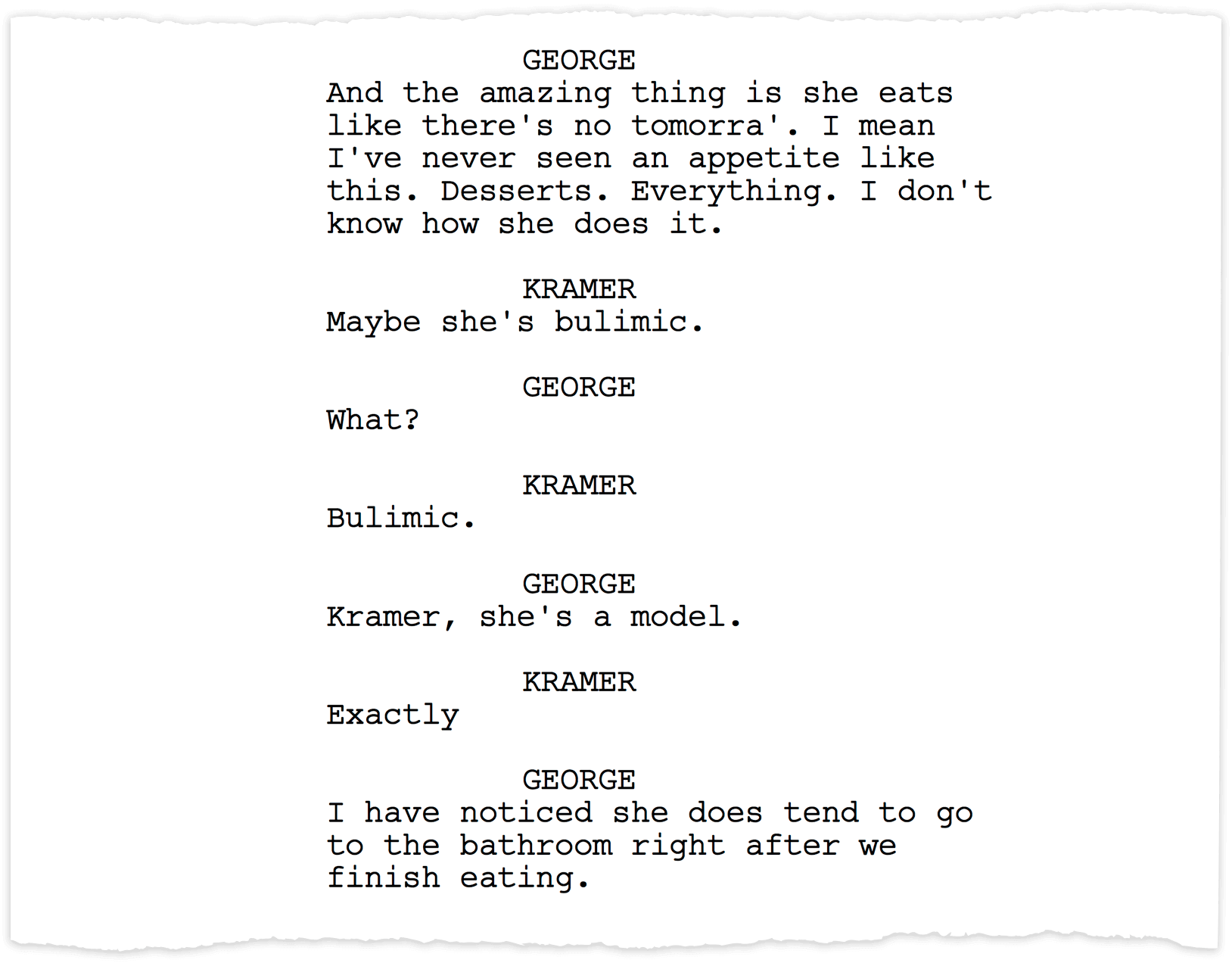

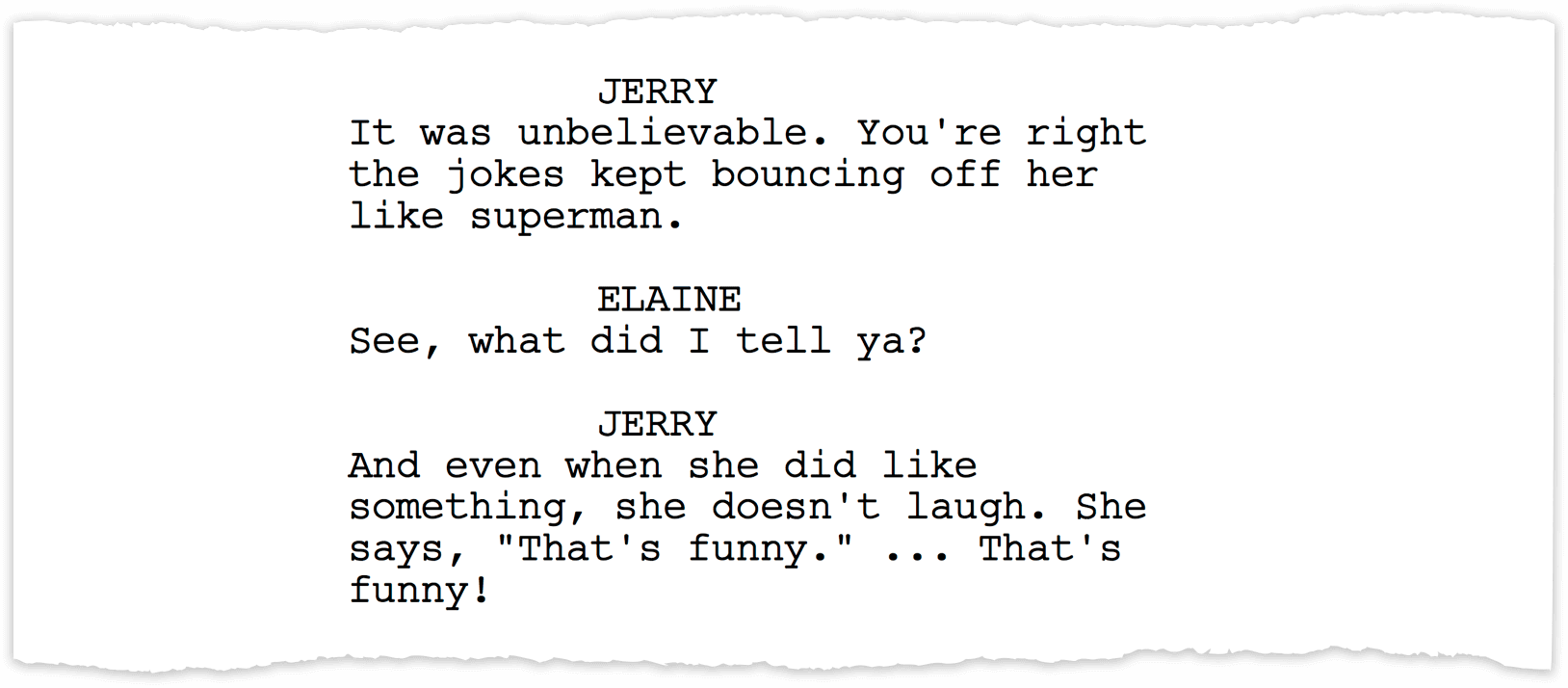
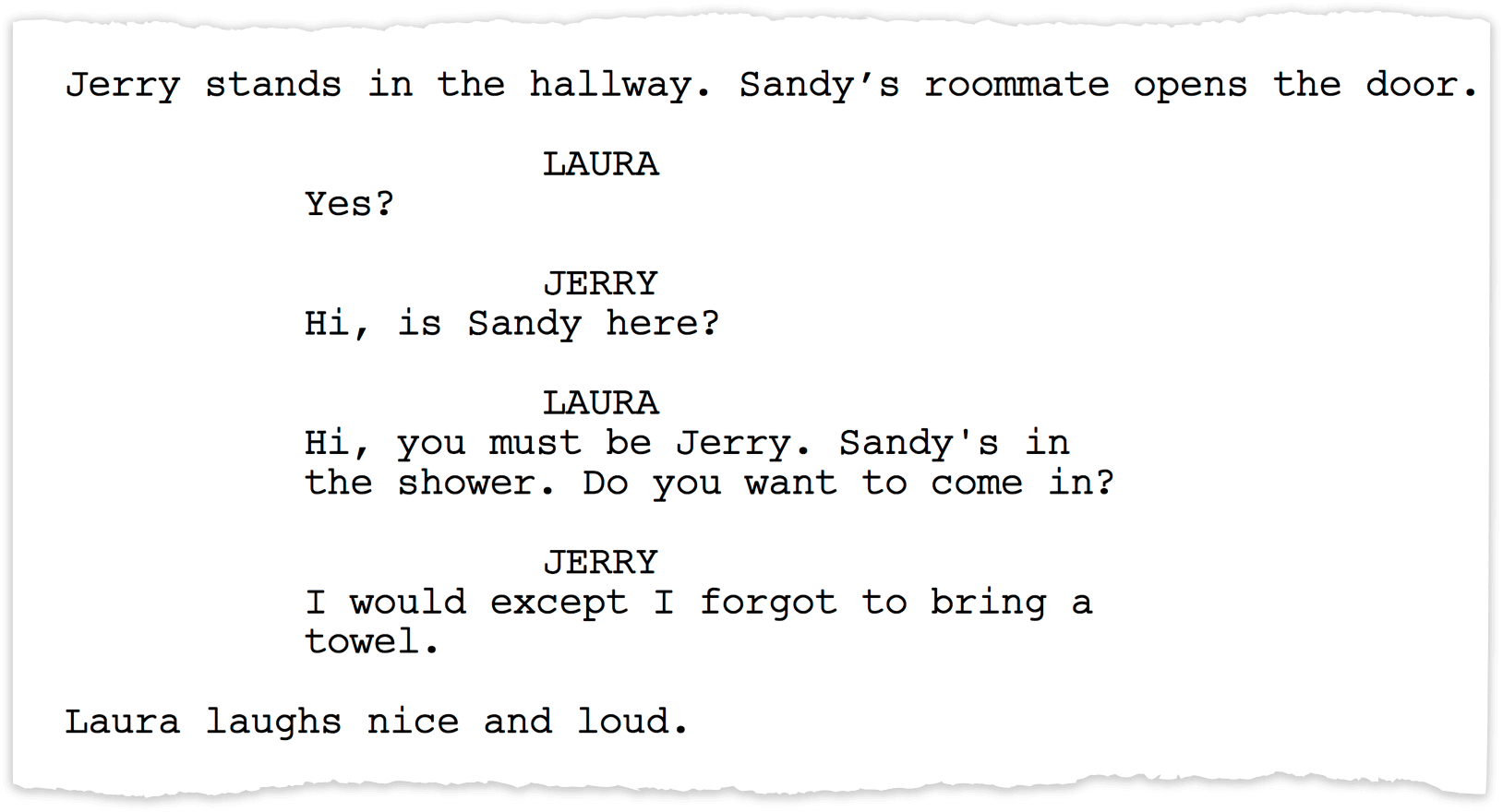
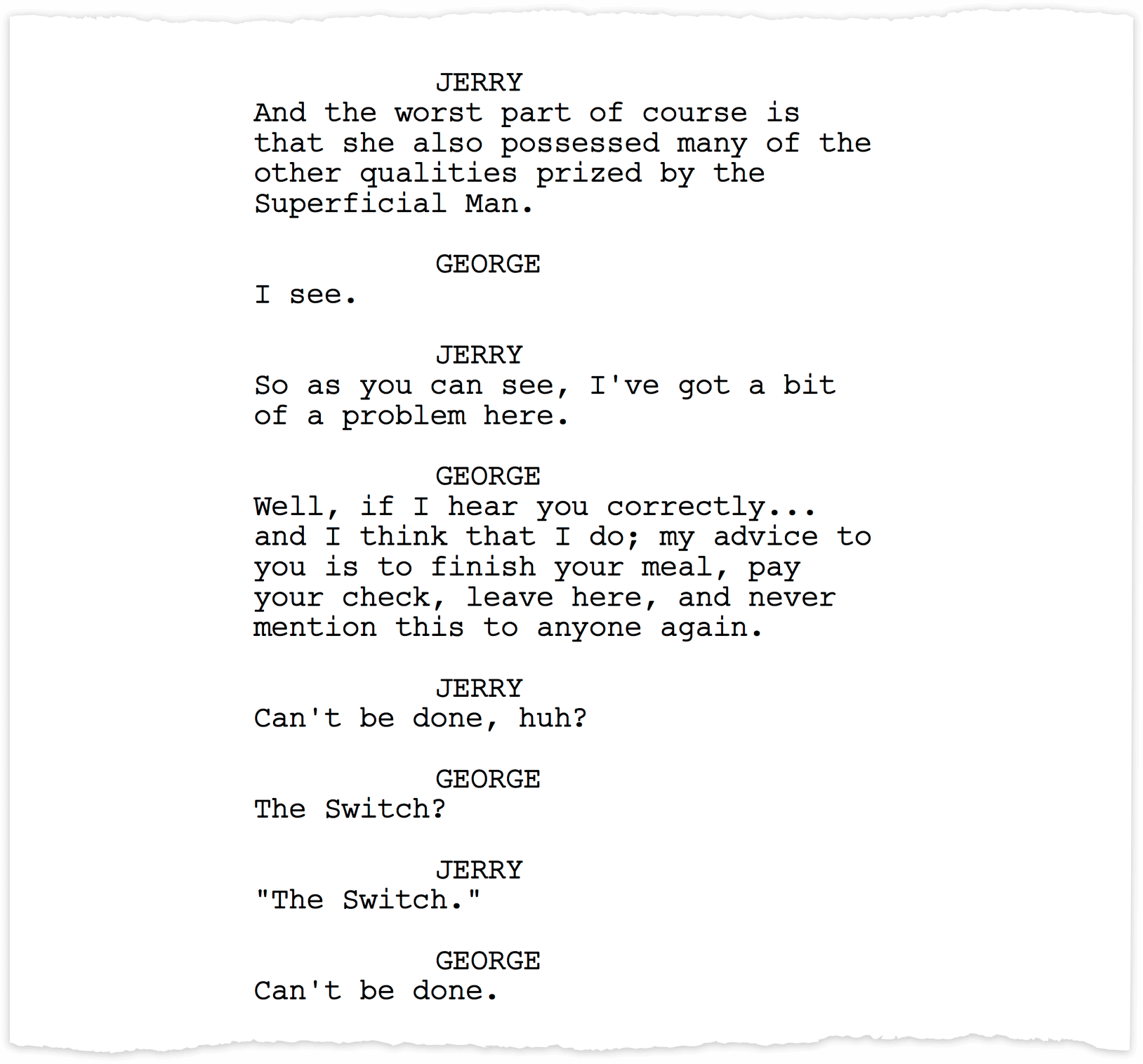
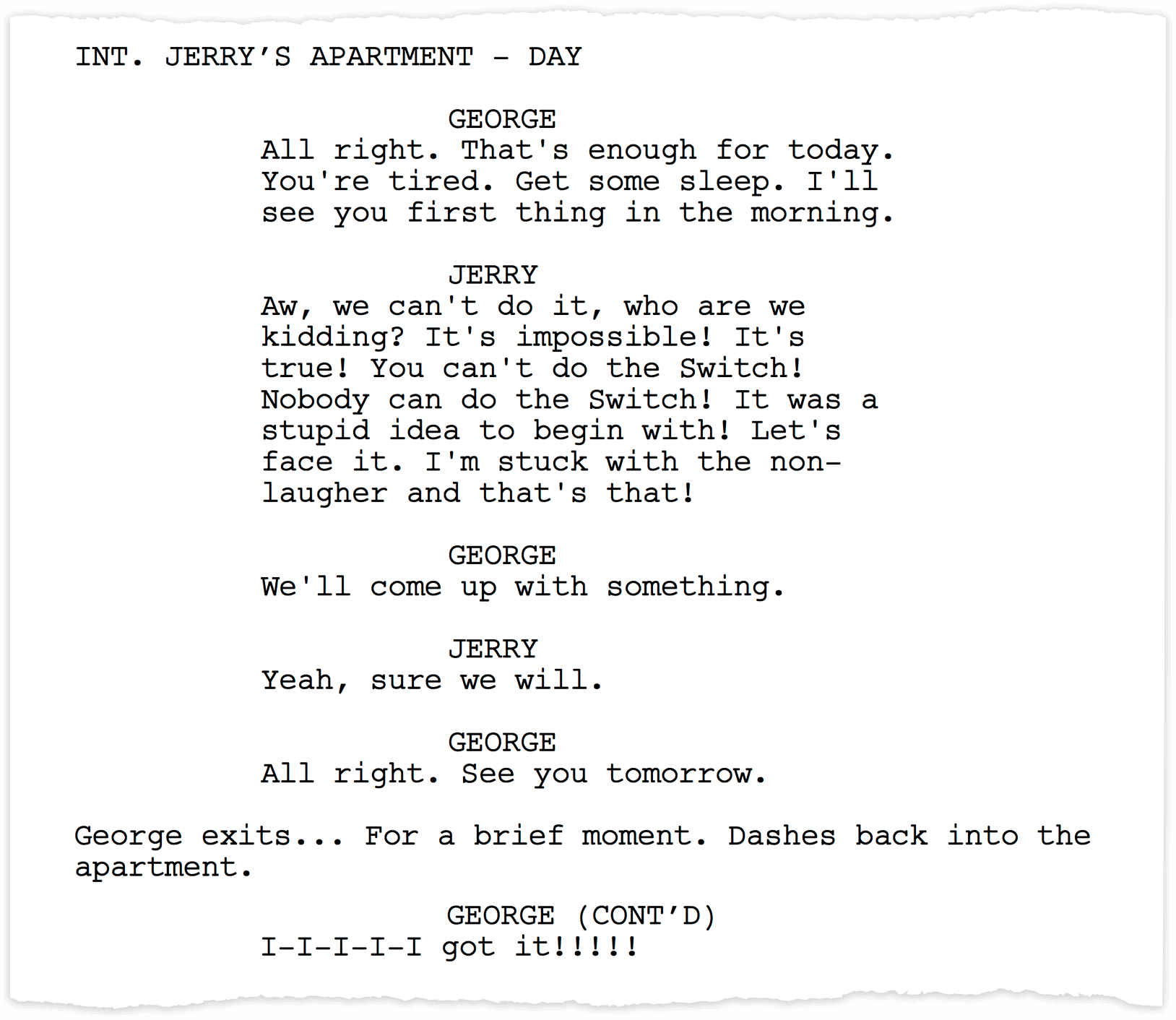
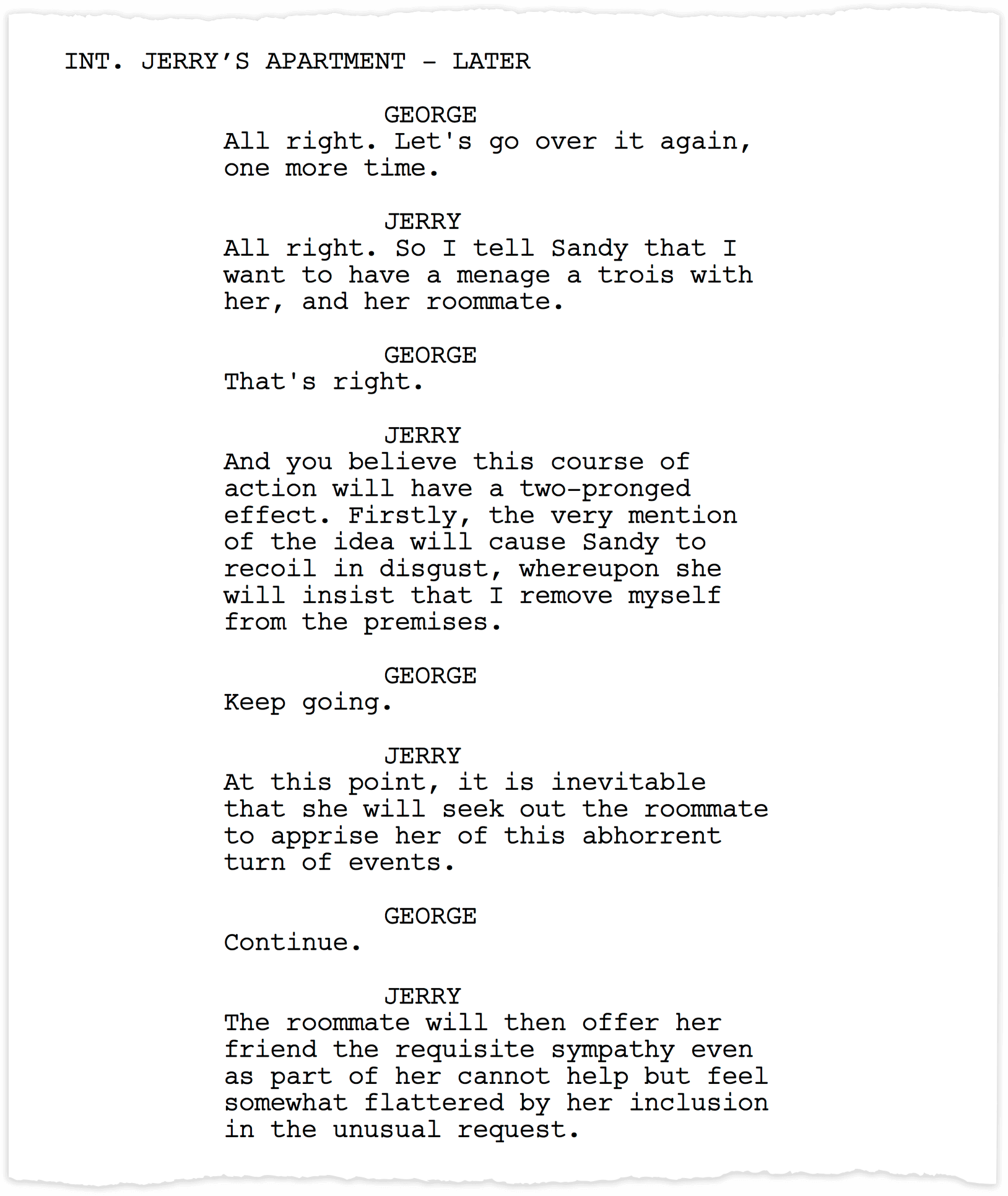
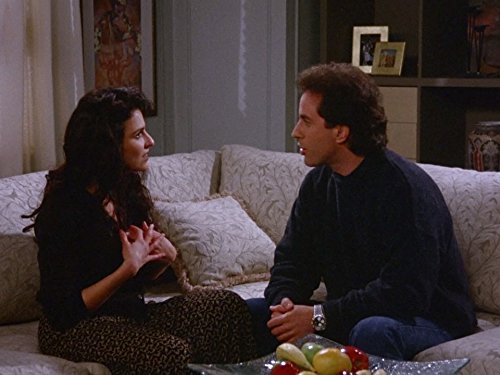
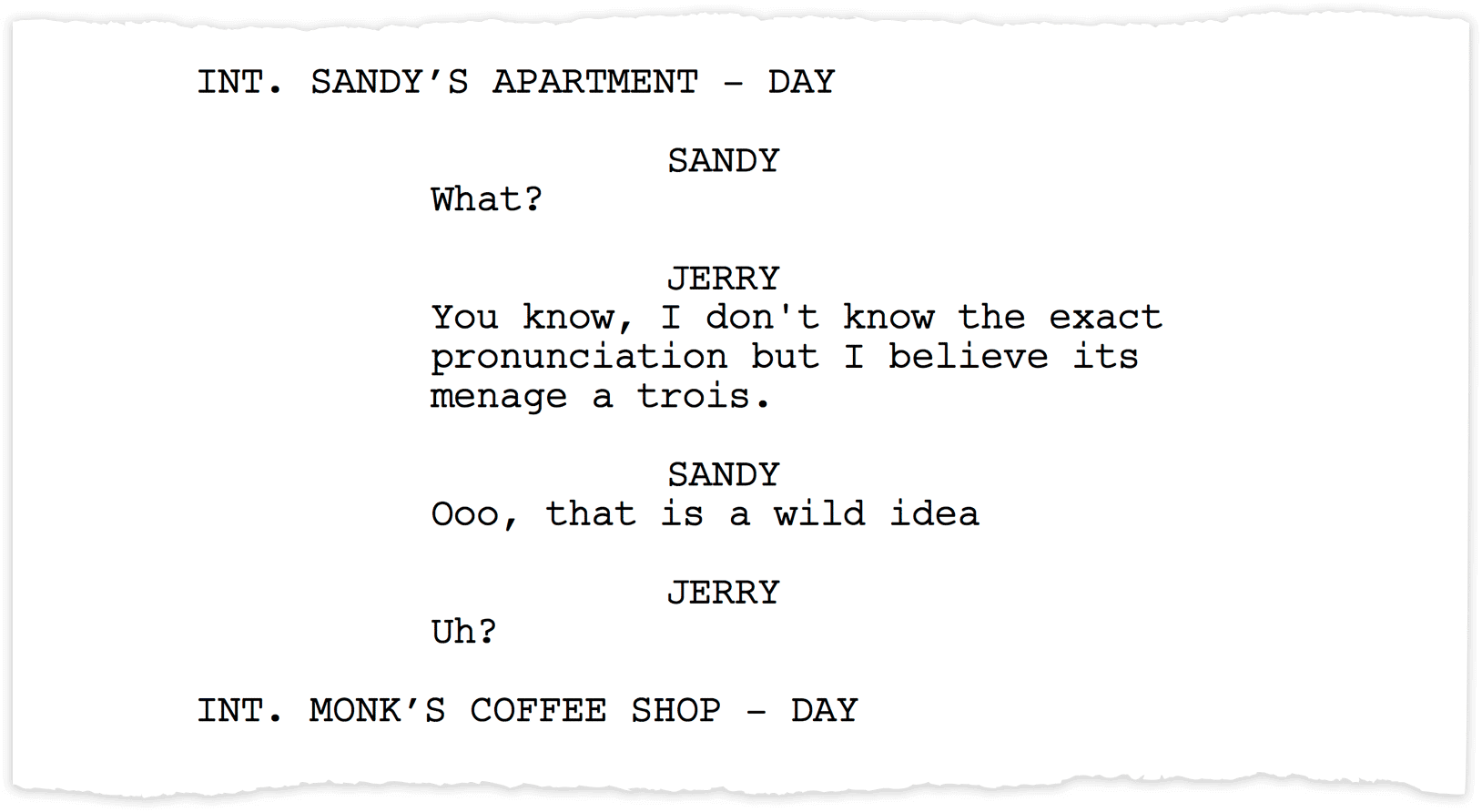
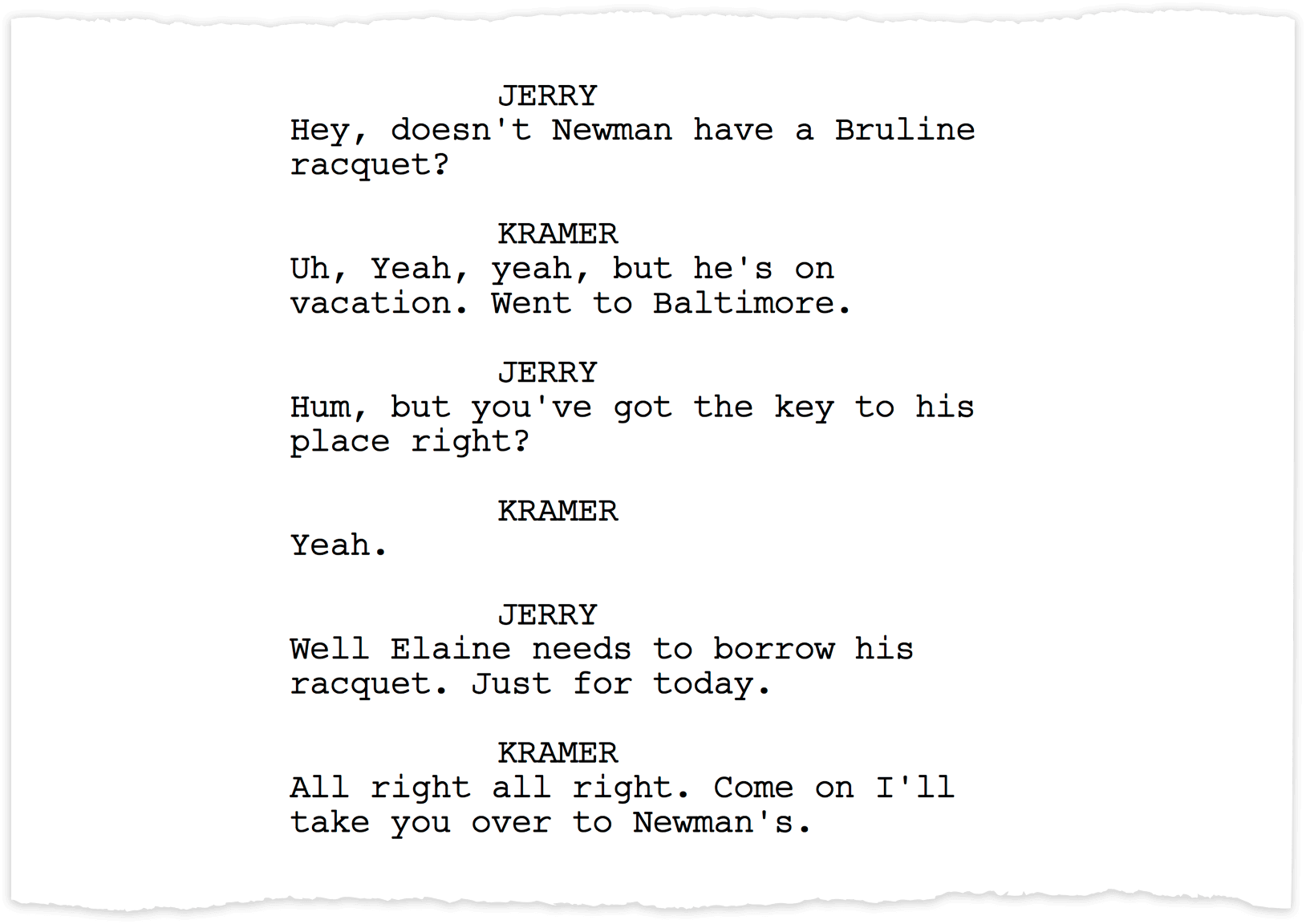
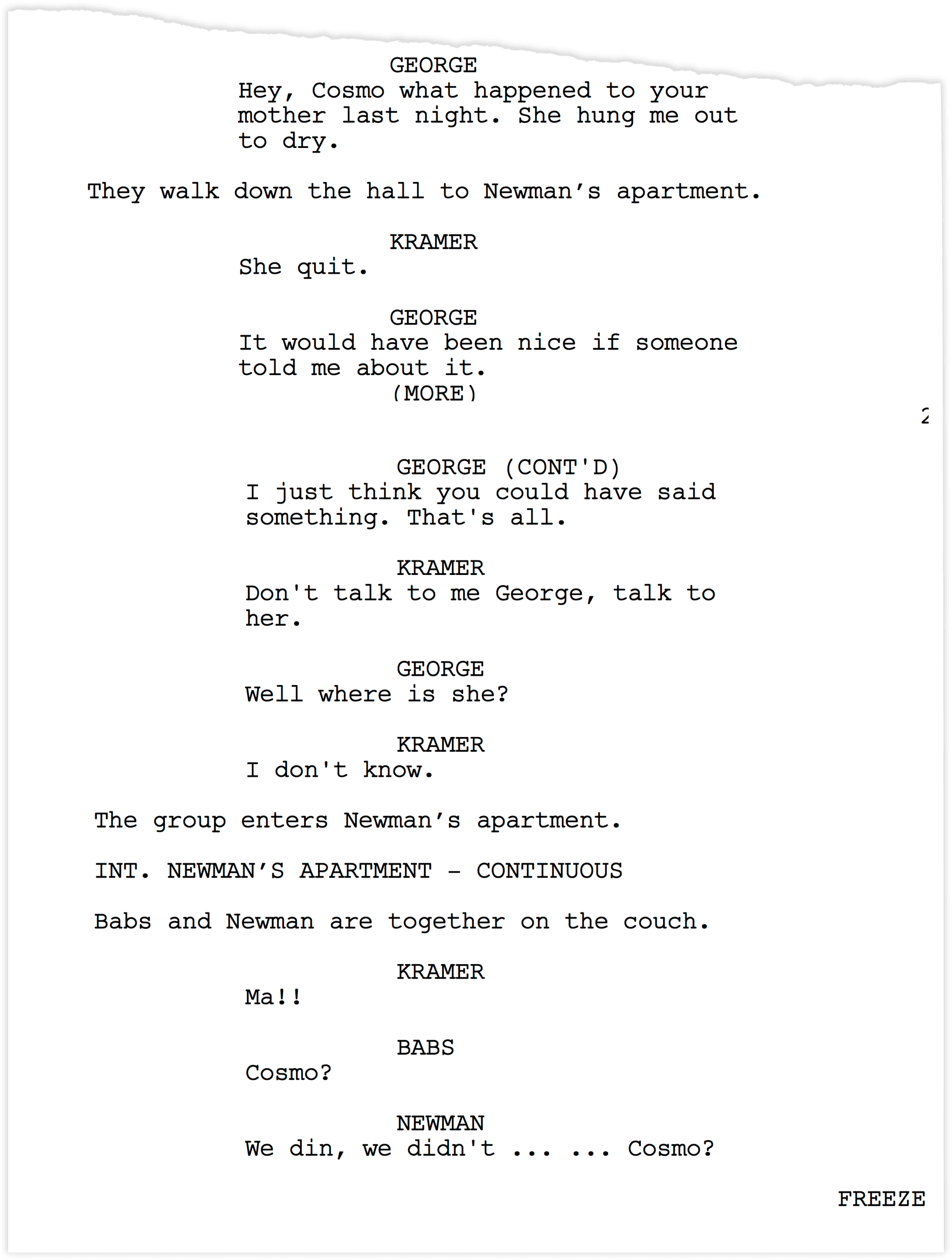
Comments
Post a Comment